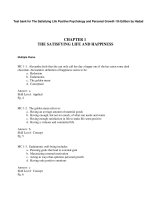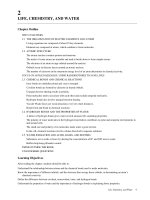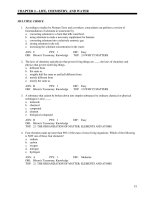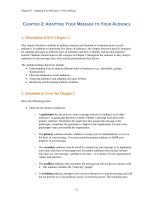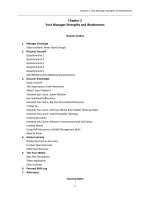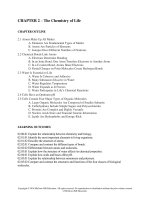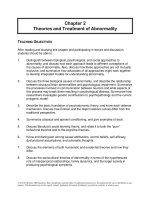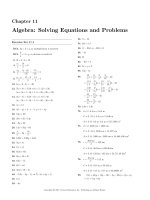Test bank and solution c2 life chemistry and water (1)
Bạn đang xem bản rút gọn của tài liệu. Xem và tải ngay bản đầy đủ của tài liệu tại đây (200.64 KB, 11 trang )
2
LIFE, CHEMISTRY, AND WATER
Chapter Outline
WHY IT MATTERS
2.1 THE ORGANIZATION OF MATTER: ELEMENTS AND ATOMS
Living organisms are composed of about 25 key elements.
Elements are composed of atoms, which combine to form molecules.
2.2 ATOMIC STRUCTURE
The atomic nucleus contains protons and neutrons.
The nuclei of some atoms are unstable and tend to break down to form simpler atoms.
The electrons of an atom occupy orbitals around the nucleus.
Orbitals occur in discrete layers around an atomic nucleus.
The number of electrons in the outermost energy level of an atom determines its chemical activity.
FOCUS ON APPLIED RESEARCH: USING RADIOISOTOPES TO SAVE LIVES
2.3 CHEMICAL BONDS AND CHEMICAL REACTIONS
Ionic bonds are multidirectional and vary in strength.
Covalent bonds are formed by electrons in shared orbitals.
Unequal electron sharing results in polarity.
Polar molecules tend to associate with each other and exclude nonpolar molecules.
Hydrogen bonds also involve unequal electron sharing.
Van der Waals forces are weak attractions over very short distances.
Bonds form and break in chemical reactions.
2.4 HYDROGEN BONDS AND THE PROPERTIES OF WATER
A lattice of hydrogen bonds gives water several unusual, life-sustaining properties.
The polarity of water molecules in the hydrogen-bond lattice contributes to polar and nonpolar environments in
and around cells.
The small size and polarity of its molecules make water a good solvent.
In the cell, chemical reactions involve solutes dissolved in aqueous solutions.
2.5 WATER IONIZATION AND ACIDS, BASES, AND BUFFERS
Substances act as acids or bases by altering the concentrations of H + and OH- ions in water.
Buffers help keep pH under control.
THINK OUTSIDE THE BOOK
UNANSWERED QUESTIONS
Learning Objectives
After reading the chapter, students should be able to:
Understand the relationship between atoms and the chemical bonds used to make molecules.
Know the importance of different orbitals, and the electrons that occupy those orbitals, in determining an atom’s
chemical reactivity.
Define the difference between covalent, noncovalent, ionic, and hydrogen bonds.
Understand the properties of water and the importance of hydrogen bonds in explaining those properties.
Life, Chemistry, and Water
9
Describe how fats and proteins can enter the pathways of energy release.
Determine whether a molecule is polar or nonpolar based on its chemical structure.
Understand pH and discuss the role of H+ and OH- ions in buffers.
Key Terms
bioremediation
radioisotope
hydrogen bonds
solute
element
tracers
van der Waals forces
concentration
matter
orbital
reactants
atomic weight
trace elements
energy levels
products
Avogadro’s number
atoms
shells
chemical equations
molecular weight
molecules
valence electrons
water lattice
mole
formula
chemical bonds
ice lattice
molarity
compounds
ionic bonds
specific heat
dissociate
atomic nucleus
ions
calories
hydrogen ions
electrons
cation
calorie
hydroxide ions
protons
anion
kilocalorie
reversible
atomic number
covalent bonds
heat of vaporization
acids
neutrons
electronegativity
cohesion
bases
isotopes
adhesion
acidity
dalton
nonpolar covalent
bonds
surface tension
pH scale
mass number
polar covalent bonds
bilayer
acid precipitation
mass
polar associations
hydration layer
buffers
weight
nonpolar associations
solution
radioactivity
hydrophilic
solvent
hydrophobic
Lecture Outline
Why It Matters
A. All plants, animals, and other organisms are collections of atoms and molecules linked together by
chemical bonds.
B. The element selenium is natural and necessary for growth and survival of organisms; however, high
concentrations of selenium are toxic.
1. In 1983 at the Kesterson Wildlife Refuge, thousands of dead or deformed waterfowl were found.
2. The problem was linked to high concentrations of selenium being washed into the refuge by decades of
irrigation.
3. With the problem identified, new agriculture practices are allowing restoration of the Kesterson refuge.
C. Studying selenium and its biological effects suggested a possible way to prevent it from accumulating in
the environment.
1. Norman Terry and coworkers tested natural methods of removing excess selenium.
2. Wetland plants were found to remove up to 90% of selenium in wastewater from a gasoline refinery.
3. The selenium was converted into methyl selenide, a relatively nontoxic gas, and dispersed into the
atmosphere.
D. Norman Terry and coworkers then tested the effects of bioremediation on agricultural plots.
1. Wetland plants in 10 experimental plots were tested (Figure 2.1).
2. Selenium was reduced to nontoxic levels (two parts per billion).
E. The selenium example shows the importance of understanding and applying chemistry in biology.
1. These reactions involving selenium are only a few of the chemical reactions that take place in living
organisms.
10 Chapter Two
2.
3.
Decades of research have confirmed that the same laws of chemistry and physics govern both living
and nonliving things.
Therefore, an understanding of the relationship between the structure of chemical substances and their
behavior is the first step in learning biology.
2.1 The Organization of Matter: Elements and Atoms
A. There are 92 different elements occurring naturally on Earth, and more than 15 artificial elements have
been synthesized in the laboratory.
1. An element is a pure substance that cannot be broken down into simpler substances by ordinary
chemical or physical techniques.
2. Matter is anything that occupies space and has mass.
B. Living organisms are composed of about 25 key elements.
1. Four elements make up 96% of the weight of living organisms: carbon, hydrogen, oxygen, and
nitrogen.
2. Seven elements compose most of the remaining 4%: calcium, phosphorus, potassium, sulfur, sodium,
chlorine, and magnesium.
3. Trace elements are those that compose <0.01% of an organism.
4. The relative proportion of different elements in humans, plants, Earth’s crust, and seawater are quite
different from one another (Figure 2.2).
a. The differences in the proportions of elements in living organisms compared to those in Earth’s
crust and seawater reflect the highly ordered chemical structure of living organisms.
C. Elements are composed of atoms, which combine to form molecules.
1. Atoms are the smallest units that retain the chemical and physical properties of an element.
2. Atoms are identified by a one- or two-letter symbol (Table 2.1).
3. Atoms combine in fixed numbers and ratios to form molecules of living and nonliving molecules.
a. Oxygen is a molecule formed from the chemical combination of two oxygen atoms.
b. Carbon dioxide is a molecule of one carbon and two oxygen atoms chemically combined.
c. The name of the molecule is written in chemical shorthand as a formula using the symbols O 2 and
CO2.
4. Molecules whose component atoms are different, such as carbon dioxide, are called compounds.
a. Chemical and physical properties of compounds are different from the atoms that make them up.
b. Water (H2O) is liquid, while hydrogen (H2) and oxygen (O2) are both gases.
c. Water (H2O) does not burn, while hydrogen (H2) and oxygen (O2) are quite explosive.
2.2 Atomic Structure
A. All atoms consist of the same basic structure, an atomic nucleus surrounded by one or more electrons
(Figure 2.3).
1. The electrons may occupy more than 99.99% of the space, and the nucleus makes up more than
99.99% of the total mass.
B. The atomic nucleus contains protons and neutrons.
1. All atomic nuclei contain positively charged particles called protons.
a. The number of protons in the nucleus of each kind of atom is referred to as the atomic number and
specifically identifies the atom.
b. The smallest atom is hydrogen and has a single proton in its nucleus (an atomic number of 1).
c. The heaviest naturally occurring element is uranium and has 92 protons in its nucleus (an atomic
number of 92).
d. Carbon has six protons, nitrogen has seven, and oxygen has eight; therefore, they have atomic
numbers of 6, 7, and 8 respectively (Table 2.1).
2. The nucleus of all atoms (except one) contains uncharged particles called neutrons.
a. The neutrons occur in variable numbers approximately equal to the number of protons.
b. The exception is hydrogen; its nucleus commonly contains only one proton.
c. Forms of hydrogen that contain neutrons are deuterium (one neutron with one proton in nucleus)
and tritium (two neutrons with one proton in nucleus).
3. Other atoms have common and less common forms with different numbers of nuclei.
a. Carbon’s most common form has six protons and six neutrons; the next most common (1%)
contains six protons and seven neutrons.
4. Distinct forms of the atoms of an element with the same number of protons but different numbers of
neutrons are called isotopes (Figure 2.4).
Life, Chemistry, and Water
11
a.
Various isotopes of an atom differ in mass and other physical characteristics, but all have
essentially the same chemical properties.
5. Atoms are assigned a mass number based on the total number of protons and neutrons in the atomic
nucleus.
a. Neutrons and protons have almost the same mass: 1.66 x 10 -24 grams (g).
b. The standard unit of atomic mass is the dalton, named after John Dalton.
c. The electrons are ignored because they are so small (1/1800 the mass of a proton).
d. A hydrogen isotope with only one proton in its nucleus has a mass number of 1, and its mass is 1
dalton. Deuterium has a mass number of 2, and tritium 3.
e. Carbon with six protons and six neutrons has a mass number of 12, expressed as 12C or carbon-12.
A Carbon with six protons and seven neutrons has a mass number of 13, expressed as 13C or
carbon-13.
6. Mass compared to weight.
a. Mass is the amount of matter in an object.
b. Weight measures the pull of gravity on an object.
c. Weight can change with the pull of gravity; near weightless conditions occur in outer space.
d. As long as an object is on the Earth’s surface, measures of weight are equivalent.
C. The nuclei of some atoms are unstable and tend to break down to form simpler atoms.
1. The nuclei of some isotopes are unstable and can break down or decay.
a. Radioactivity is particles of matter and energy given off by the breakdown of unstable isotopes.
b. An unstable, radioactive isotope is called a radioisotope.
c. The decay or breakdown occurs at a steady rate.
d. The radioisotope can break down to other elements.
e. In carbon-14, one of its neutrons splits into a proton and an electron. The electron is ejected from
the nucleus, but the proton is retained, giving a new total of seven protons and seven neutrons,
which is nitrogen.
2. Estimating age of organic material using unstable isotopes.
a. These techniques have been vital in dating animal remains and tracing evolutionary lineages
(Chapter 22).
b. Isotopes are easily detected and are used in biological research as tracers. Common tracers
included 14C, 32P, and 35S.
D. The electrons of an atom occupy orbitals around the nucleus.
1. The number of electrons surrounding the nucleus is equal to the number of protons in the nucleus (a
neutral atom).
2. Electrons move very fast around a nucleus, approaching the speed of light.
a. Electrons spend most of their time in specific regions around the nucleus called orbitals.
b. Most orbitals contain two electrons for balance.
3. Electrons are maintained in their orbitals by a combination of attraction to positively charged protons
and repulsion by negatively charged electrons.
4. Electrons can sometimes move from one orbital to another.
E. Orbitals occur in discrete layers around an atomic nucleus.
1. An atom contains regions of space called energy levels, or simply shells.
a. The closest orbital has a spherical shape (1s), found in hydrogen and helium.
2. Atoms between atomic numbers 3 and 10 have two energy levels. Two electrons occupy the first
orbital (1s). One to eight electrons occupy orbitals in the next energy level (Figure 2.5).
3. The third energy level, which may contain as many as 18 electrons in 9 orbitals, includes atoms from
sodium (11 electrons) to argon (18 electrons).
a. No matter the number of orbitals, the outermost energy level typically contains one to eight
electrons, occupying a maximum of four orbitals.
F. The number of electrons in the outermost energy level of an atom determines its chemical activity.
1. Electrons in the outermost energy level are known as valence electrons.
a. Atoms with the outermost energy level not completely filled with electrons tend to be chemically
reactive.
b. Hydrogen with one electron is highly reactive, while helium with two and a full outer shell is inert.
c. Atoms with higher than two electrons commonly need eight electrons to fill the outer shell.
2. Atoms with outer energy levels that contain electrons near the stable number tend to gain or lose
electrons.
12 Chapter Two
a.
3.
Sodium has one electron in its outer shell and tends to lose that electron to leave the inner level
with a full eight.
b. Chlorine with seven electrons in its outer shell tends to gain an electron to have a stable eight in
the outer shell.
Atoms that have a stable configuration by more than one or two electrons tend to share electrons in
joining orbitals with other atoms to reach a stable configuration.
a. Oxygen and nitrogen tend to share electrons with other atoms.
Focus on Applied Research: Using Radioisotopes to Save Lives
A. Radioisotopes are used to diagnose and cure diseases.
1. Radioisotopes are used to diagnose thyroid gland diseases.
2. The thyroid gland absorbs iodine in large quantities.
3. By injecting small amounts of radioactive iodine in a patient’s blood, an image of the thyroid can be
made from the radioactivity from the thyroid.
B. Treatment using radioactivity uses the fact that high doses of radioactivity kill cells.
1. Dangerously overactive thyroid glands are treated using calculated doses of radioactive iodine to kill
cells and bring the cells into a normal production level.
2.3 Chemical Bonds and Chemical Reactions
Four chemical linkages that are important for biological systems are ionic, covalent, and hydrogen bonds as
well as van der Waals forces.
A. Ionic bonds are multidirectional and vary in strength.
1. Ionic bonds occur between atoms that lose or gain valance electrons, forming a positive or negative
ion.
a. For example, sodium can give up an electron to become a positive 1 charge (called a cation), and
chlorine can take an electron to become a negative 1 (called an anion) (Figure 2.7).
b. The difference in charge that causes the two ions to attract to each other is an ionic bond.
2. Many atoms can lose or gain electrons in the outer shell. When hydrogen loses its one electron, all that
remains is a proton. This is often called a proton. When other atoms lose or gain electrons, the symbol
reflects it with a positive or negative number (e.g., Mg2+, Fe2+, or Ca2+).
3. Ionic bonds hold ions, atoms, and molecules together in living organisms and have three key features.
a. They exert an attractive force over a greater distance than any other bond.
b. Their attractive force extends in all directions.
c. They vary in strength depending on the presence of other charged substances.
d. These features lead to certain molecules being held tightly by ionic bonds, like metal ions in
biological molecules, or weakly, like water molecules. Many enzymatic proteins bind and release
molecules by forming and breaking relatively weak ionic bonds.
B. Covalent bonds are formed by electrons in shared orbitals.
1. Covalent bonds form when electrons are shared to fill valance electrons—such as hydrogen (H2) when
two atoms come together, each with one electron in the outer shell, and share to make two electrons in
the low-energy shell, filling that valance.
2. The description of H2 is represented as H:H or H-H.
3. Unlike ionic bonds, covalent bonds form attractions in directions forming three-dimensional structures.
4. Carbon with four electrons in its outer shell forms four covalent bonds. These bonds can be with
separate molecules like hydrogen or form double or triple bonds with oxygen or nitrogen.
5. Oxygen, hydrogen, nitrogen, and sulfur often form covalent bonds in biological molecules with oxygen
forming two, hydrogen forming one, nitrogen forming three, and sulfur forming two.
C. Unequal electron sharing results in polarity.
1. Electronegativity is the measure of an atom’s attraction for an electron shared in a chemical bond.
2. Atoms vary in electronegativity and, therefore, share electrons differently.
a. Nonpolar covalent bonds share electrons equally.
b. Polar covalent bonds share electrons unequally.
c. There is great variation in the sharing of electrons, giving part of the molecule a partial charge and
no clear line between polar and nonpolar.
3. Examples of nonpolar bonds are hydrogen (H 2) and oxygen (O2).
4. An example of polar bonds is water (Figure 2.9). Oxygen is more electronegative and gives partial
charges to the molecule.
a. The bonds are at angles, giving a unique shape and charge distribution.
Life, Chemistry, and Water
13
b. The partial charge allows water to dissolve polar materials.
Oxygen, nitrogen, and sulfur all share electrons unequally; therefore, when they are present, the
molecules tend to be more polar. (e.g., –OH, NH, or SH groups).
6. Carbon and hydrogen share electrons unequally; however, the distribution of hydrogen around a
carbon (for example, CH4) tends to cancel out to make the molecule as a whole nonpolar.
D. Polar molecules tend to associate with each other and exclude nonpolar molecules.
1. Polar molecules associate more readily with each other and are called hydrophilic (water-preferring),
while nonpolar molecules do not associate with polar molecules and are called hydrophobic (wateravoiding).
2. An example of this can be demonstrated with water and vegetable oil. Place each in a single container
and mix. After the bottle is at rest, the two will separate.
E. Hydrogen bonds also involve unequal electron sharing.
1. Hydrogen atoms are often made partially positive by unequal sharing with atoms, and these weak
positive charges can attract the weak negative charges on other molecules, forming weak bonds called
hydrogen bonds (Figure 2.10a).
2. Hydrogen bonds are weak compared to ionic or covalent bonds but are important in maintaining the
stability of the large three-dimensional structure of biological molecules.
3. These weak bonds tend to be easy to break and will start breaking at 45 oC and be nonexistent at
100 oC.
a. Thermophilic (temperature-loving) organisms have special biological molecules that are stable at
these temperatures.
F. Van der Waals forces are weak attractions over very short distances.
1. Van der Waals forces are created by electrons accumulating by change in one part of a molecule,
causing a partial charge.
2. A striking example is of geckos walking up a vertical, smooth surface (Figure 2.11).
a. The toes are covered with millions of hairs, called setae, that are about 100 micrometers; at the tip
are thousands of toe pads that are about 200 nanometers (smaller than the wavelength of visible
light).
b. Study of this has led to the development of a super adhesive prototype tape capable of holding
3 kg of weight with a 1 cm2 piece.
G. Bonds form and break in chemical reactions.
1. Chemical reactions occur when atoms or molecules interact to form new chemical bonds or break old
ones.
a. Chemical reactions are accelerated by enzymes (Chapter 4).
2. Atoms or molecules entering a reaction are called reactants, while atoms or molecules leaving a
reaction are called products.
3. For example, the overall reaction of photosynthesis: 6 carbon dioxide + 6 water (reactants) + light a
sugar + 6 oxygen (products).
a. The number in front of each molecule is the number of molecules of that type in the reaction.
b. The chemical equation is written 6CO2 + 6H2O + light C6H12O6 + 6O2.
4. You are now ready to examine the properties of water.
5.
2.4 Hydrogen Bonds and the Properties of Water
A. Water is crucial for life; between 50 and 95% of an organism is made of water.
B. A lattice of hydrogen bonds gives water several unusual, life-sustaining properties.
1. The differing densities of water and ice.
a. Hydrogen bonds form readily between liquid water molecules, forming a constantly changing
water lattice (Figure 2.12).
b. In ice, the water lattice is a rigid crystalline structure, with bonds further apart than in liquid water.
c. Bonds in ice being at greater distances than in liquid water makes ice 10% less dense when solid.
(Almost all other substances are denser in solid form than liquid form.)
d. Water’s greatest density is at 4 oC while it is still a liquid.
e. Because ice is less dense, it will float on water as it freezes, creating an insulating layer that keeps
water below the ice from freezing solid and making life possible for aquatic plants and animals.
2. The boiling point and temperature-stabilizing effects of water.
a. More heat is required to break the hydrogen-bond lattice of liquid water and make water boil.
b. Molecules that do form the hydrogen-bond lattice have lower boiling point.
14 Chapter Two
c.
Water has a relatively higher specific heat—the amount of heat required to increase the
temperature.
d. Higher specific heat of water has a stabilizing effect on living organisms and their environment.
e. The specific heat of water is measured in calories—a unit that refers to the amount of heat
required to raise the temperature of 1 g of water by 1 °C.
f. Water has high heat of vaporization—the amount of heat required to break loose water molecules
to go from liquid water to gas.
g. High heat of vaporization allows humans and other organisms to cool off when hot and prevents
increase of body temperature.
3. Cohesion and surface tension
a. The high resistance of water molecules to separate and be able to maintain the hydrogen-bond
lattice is known as cohesion.
b. Water also bonds with other polar molecules—adhesion.
c. Microscopic tubes that extend from the roots to the highest leaves allow water to rise with the
help of cohesion and adhesion.
d. Water molecules on the surface of large bodies of water bond with each other to create a strong
force called the surface tension (Figure 2.13).
e. Surface tension allows small insects to land or walk on water.
C. The polarity of water molecules in the hydrogen-bond lattice contributes to polar and nonpolar
environments in and around cells.
1. Polar substances can disturb the water lattice by creating temporary hydrogen bonds with the water
molecules and, therefore, can move in the lattice. Nonpolar molecules cannot disturb the lattice; thus a
drop of oil will remain on the surface of water and form spheres when shaken.
2. Distinct polar and nonpolar environments created by water are critical to the organization of cells.
a. Biological cell membranes have polar and nonpolar components, allowing the formation of a
double layer, or bilayer (Figure 2.14).
3. The membrane prevents mixing of materials inside and outside the cell, which is necessary for life.
D. The small size and polarity of its molecules make water a good solvent.
1. The hydration layer (water penetrating the surface of substances) allows water to reduce the attraction
between molecules or ions and promotes their separation and entry into a solution, where they are
suspended individually, surrounded by water molecules.
a. Water is called the solvent in such a solution.
b. The substance dissolved is called the solute.
2. Example: When table salt is added to water, the hydration layer quickly penetrates the ions of salt and
separates Na+ and Cl- (Figure 2.15). If the water evaporates, the Na+ and Cl- reform to salt.
E. In the cell, chemical reactions depend on solutes dissolved in aqueous solutions.
1. The reactions are dependent on concentration—the number of molecules or ions of substance in a unit
volume of space.
2. The mass number of atoms can be added to calculate the weight of any molecule.
a. Carbon has six protons and six neutrons, each 1.66 x 10-24 g: 12*1.66 x 10-24 = 1.992 x 10-23.
b. Dividing the total weight of an element by the weight of a single atom gives the total number of
atoms in that sample: 12 g / 1.992 x 10-23 = 6.022 x 1023 number of atoms.
c. In fact, if you divide the atomic weight of oxygen (16) by the weight of on oxygen atom you get
the same number.
d. This number is called Avogadro’s number.
3. This relationship holds true for molecules as well.
4. When concentrations are described, the amount containing 6.022 x 1023 atoms or molecules is known
as a mole (mol). The number of moles of a substance dissolved in one liter of solution is known as the
molarity (M). This is useful in chemistry and biology, because if we have two solutions of the same
molarity we know we have the same number of molecules of each.
Life, Chemistry, and Water
15
2.5 Water Ionization and Acids, Bases, and Buffers
A. Substances act as acids or bases by altering the concentrations of H + and OH- ions in water.
Water can dissociate into hydrogen ions (H+ or protons) and hydroxide ions (OH-).
1. In pure water, the hydrogen and hydroxide ions are equal; however, when you add some substances,
this ratio is altered.
a. Hydrochloric acid dissociates to add a proton to water: HCl H+ H+ Cl-.
b. Other substances are bases that take a proton from water: NaOH Na+ + OH-.
The OH- + H+ H2O.
2. Some substances directly accept a proton, like ammonia NH 3.
3. The concentration of H+ compared to OH- determines the acidity of the solution, measured on a
logarithmic scale from 0 to 14.
a. Equation: pH = -log10 [H+]. Concentrations are in moles per liter.
b. A pH of 7 is neutral because of the negative log; low pH indicates acids, and high pH indicates
base conditions (Figure 2.16).
4. pH is important to cells because very small changes in pH (0.1 or 0.01) can cause drastic changes in
biological reactions.
5. Acidity is also important in the environment. Acid rain falls with a pH of 3, near the pH of vinegar,
and can harm wildlife, such as fishes and birds (Figure 2.17).
B. Buffers help keep pH under control.
1. Living organisms maintain pH by using buffers (substances that resist change in pH). Buffers can
release or add H+ to solution.
a. Strong acids and bases dissociate completely like HCl or NaOH.
2. Most buffers are weak acids or bases that only partially dissociate in water. Bicarbonate ions are the
most common buffer in blood: H2CO3 HCO3 + H+ (Figure 2.18).
3. Hyperventilation, breathing too fast, can drastically alter pH of blood by removing CO 2. CO2 is the
primary source of carbonic acid in the bloodstream. The alteration can cause dizziness, visual
impairment, fainting, seizures, or even death.
4. This chapter focused on basic structure of atoms and molecules; the next looks more closely at carbon
molecules.
Think Outside the Book
A. Carbonic acid – Bicarbonate is one of the buffering systems in living things.
B. Discuss with the students what happens when the body pH changes.
Unanswered Questions
A. How can the effectiveness of uranium bioremediation by bacteria in soils and sediments be optimized?
1. Uranium contamination of soils is a big concern in areas where uranium is extracted or processed.
2. One approach is to use naturally occurring bacteria whose metabolism transforms uranium from a
soluble to an insoluble form to prevent its spread into groundwater systems.
3. Li Li is examining the factors that determine the effectiveness of bioremediation treatment at a
uranium mining and processing site near Rifle, Colorado.
4. Spatial distribution of important minerals (e.g., iron) strongly influences the effectiveness of
bioremediation.
5. The complexity of the subsurface systems requires an interdisciplinary approach, involving input from
microbiologists, geochemists, hydrogeologists, and geophysicists.
Teaching Challenges
Students have many common misconceptions about chemistry. Many of these are related to bonds and bond formation.
For example, many students believe that atoms “need” to have all of the orbitals filled. Some other widely held
misconceptions are that only covalent and ionic bonds are “real” bonds and that covalent bonds occur with equal sharing
of the electron. In the literature, these misconceptions have been attributed to the use of ball-and-stick models that give a
visual representation of the stick as a chemical bond. It is important to emphasize that there are more than two types of
bonds; hydrogen bonds are very important to biological systems. The idea that atoms “need” to have their orbitals filled
is an important one to address. The idea that there is “need” in biology will also come up in later chapters, especially
those pertaining to evolution and natural selection.
16 Chapter Two
Suggestions for Presenting the Material
Bring a small amount of salt to class and a beaker of water. Dissolve the solid in front of the class. Then emphasize
that, by the lecture, they will understand why the salt molecules dissolved in water and how the nature of atoms changes
depending on the state.
Emphasize the importance of surface tension by putting water on a small glass plate (slowly) to show the curved
nature of the droplet. Discuss how the availability of hydrogen accounts for the surface tension that gives the droplet its
shape.
To reinforce the importance of van der Waals forces in biology, show a small clip of a gecko climbing on glass.
(Pictures can be found on Google images and through some zoo cams).
Bring pH paper to class and dip it into various substances: dish soap, lemon juice, a bit of saliva, anything that is
readily available. This is many times better than just looking at Figure 2.16.
Visual Learning Tips
During lecture, show the periodic table of elements (or Figure 2.6) and discuss with students that the number of bonds
an atom will form is based on its placement in the table.
To illustrate the orbitals, show two animations: the electron arrangements in atoms and then the shell model of electron
distribution. As you proceed through the lecture, students will have these visuals to draw on in order to understand the
concepts being presented.
To further help students understand the pH scale, show the animation on the pH scale in class.
Educational Websites
These websites can be used for additional materials in lecture or discussion sections. In addition, you may choose to refer
students to some of these websites for their own edification.
/> /> /> /> />
Classroom Discussion
Why It Matters
Have students discuss other instances in which bioremediation may be necessary, and how it might be accomplished.
Focus on Applied Research
Ask students why isotopes exist; ask them to explain how they are formed and why they are unstable.
Ask students to explain why exposing a cancerous tumor to radiation may help eliminate the tumor.
Unanswered Questions
Show photos of bioremediation sites before and after an oil spill. Ask students to identify the “before” and “after”
photos. Ask students to come up with ideas about how something like oil can be broken down. This can be referred to
again when discussing the bacteria and archaea domains, and the different electron donors and acceptors that are utilized
by these groups.
Additional Discussion Ideas
Bring in a bag of chips and read the calorie content on the bag. Ask students to write a one-minute paper explaining
what the term calorie really means.
Show a picture of a jacana “walking” on water, and ask students to explain to a partner how this is possible.
Discuss the pH of rain and what really causes acid rain.
Life, Chemistry, and Water
17
Discuss the path and the mechanism of water climbing up to the top of the tree.
Use examples to discuss the types of chemical bonds.
Classroom and Laboratory Enrichment
Have students create a concept map relating chemical bonds to atoms. Key words included should be: chemical bonds,
covalent, ionic, hydrogen, polar, and nonpolar. Have students build their concept map throughout lecture so the
relatedness of topics from atoms to bonds can be seen.
Have students form their own water lattice. Have multiple groups of three students make water molecules. Designate
which students represent hydrogen and which represent oxygen. Have these students join hands, then drop hands and
join hands with adjacent “oxygen.” This is a very easy way to show that there can only be two bonds at a time (people
only have two hands), but students can also see the fluidity, no pun intended, of water molecules as each hydrogen is
moving around in front of class.
Give students a list of atoms and ask them to rank the atoms from the highest to the lowest electronegativity. Next,
give them a list of molecules made from the atoms, and ask whether they expect those molecules to form polar or
nonpolar covalent bonds.
Give the students a bowl of water, and have them put some oil in the water. Have them stir it around and watch as
smaller drops of oil meet to form larger drops of oil (eventually one). Have the students write down why they think this
phenomenon occurs. Next, have them drop in some dish soap and watch what happens. Have the students describe their
observations and offer potential explanations.
Give students a list of different atoms and have them see how many molecules they can form. Afterward, ask the
students to look these atoms up in the CRC to see if they have actually been found in nature. For interesting molecules
the students predict, say something about them and where they are found in nature.
Term Paper Topics, Library Activities, and Special Projects
Ozone is a very important part of our atmosphere. Have students do a small research project on ozone and its
breakdown by chlorofluorocarbons (CFCs). Ask them to include a discussion on what types of commercial products
have changed in the past 20 years based on what we know about how ozone reacts with other molecules.
Have students do a web-based research project on bioremediation.
Genetically modified foods are growing more common on our grocery store shelves. Have students try to find specific
foods that are irradiated to kill microorganisms. This could be an interesting project for students because it is not
something that must be reported to consumers. Students should also include a paragraph about their opinion on
irradiating food, and they should use what they have learned about chemical bonds to defend their opinion.
Send students home with pH paper and ask them to keep a log of the pH of the food items they eat.
Suggested Readings
InfoTrac® College Edition Readings
“Selenium and heavy metal phytoremediation.” Industrial Bioprocessing. December, 30, 2005.
Chatal, Jean-Francoise, et al. “Radionuclide Therapy.” The Lancet. September, 11, 1999.
Jueneman, Frederic B. “A Clash of Symbols (Linguistic Roots of Gold, Silver, and Mercury).” R & D. January, 1990.
West, Robert. “Japan Bats a Triple (Silicon Triple Bond).” Science. September, 17, 2004.
Perkowitz, Sidney. “The Rarest Element (Water).” The Sciences. January, 1999.
Ashton, Nick. “Acidosis (Maintenance of pH and Acid-Base Equilibrium in Systems).” Biological Sciences Review.
February, 2006.
18 Chapter Two
Possible Responses to Think Outside the Book
1.
2.
Discuss another example of a buffering system. Recall that a buffer is something that can both donate and accept
protons.
How does this buffering system help maintain pH? Hopefully students will discuss the log scale of pH, and explain
the equilibrium reactions that many buffers are capable of in biologic conditions. You can bring them back to this
exercise when you discuss hemoglobin and the transport of carbon dioxide in the body, during the circulatory and
respiratory systems chapters.
Possible Responses to Discuss the Concepts
1.
Detergents are amphipathic, with both hydrophobic and hydrophilic regions. Because of this, they are able to
interact with both water and oil at the molecular level. This allows for the oil to “mix” with the water and release the
surface it is on.
2.
If ice were denser than liquid water, it would sink rather than float. This would be seriously detrimental to the
animal life in ponds and rivers. Most of the animal life in a small aquatic ecosystem will overwinter in the bottom of
a lake or pond. The ice on top provides an insulating layer, which prevents the water from freezing at the bottom and
protects the animals.
3.
Metal conducts heat much better than does water. The water would travel through the metal first, before warming
the water within.
4.
You could add a buffer, such as bicarbonate, to the solution. This would cause the solution to absorb the excess H +
and keep the pH constant. A bicarbonate solution is one of the many ways human blood is kept at a constant pH.
Possible Response to Design an Experiment
If you have a 0.5 M NaCl solution, you would need to add enough NaOH to have 0.5 NaOH. If you had 100mL of a 0.5
M solution of HCl, you would need 0.5 mole/L x 0.1 L x 40 g/mL = 2 g NaOH.
Possible Response to Apply Evolutionary Thinking
1.
There are many properties of water that enabled the evolution of life:
Cohesiveness (hydrogen bonding and high vapor point)
Polarity (enables a phospholipid bilayer to form)
Floats when frozen (related to the hydrogen bonding)
Resists temperature changes, which is a stabilizing variable
Life, Chemistry, and Water
19

